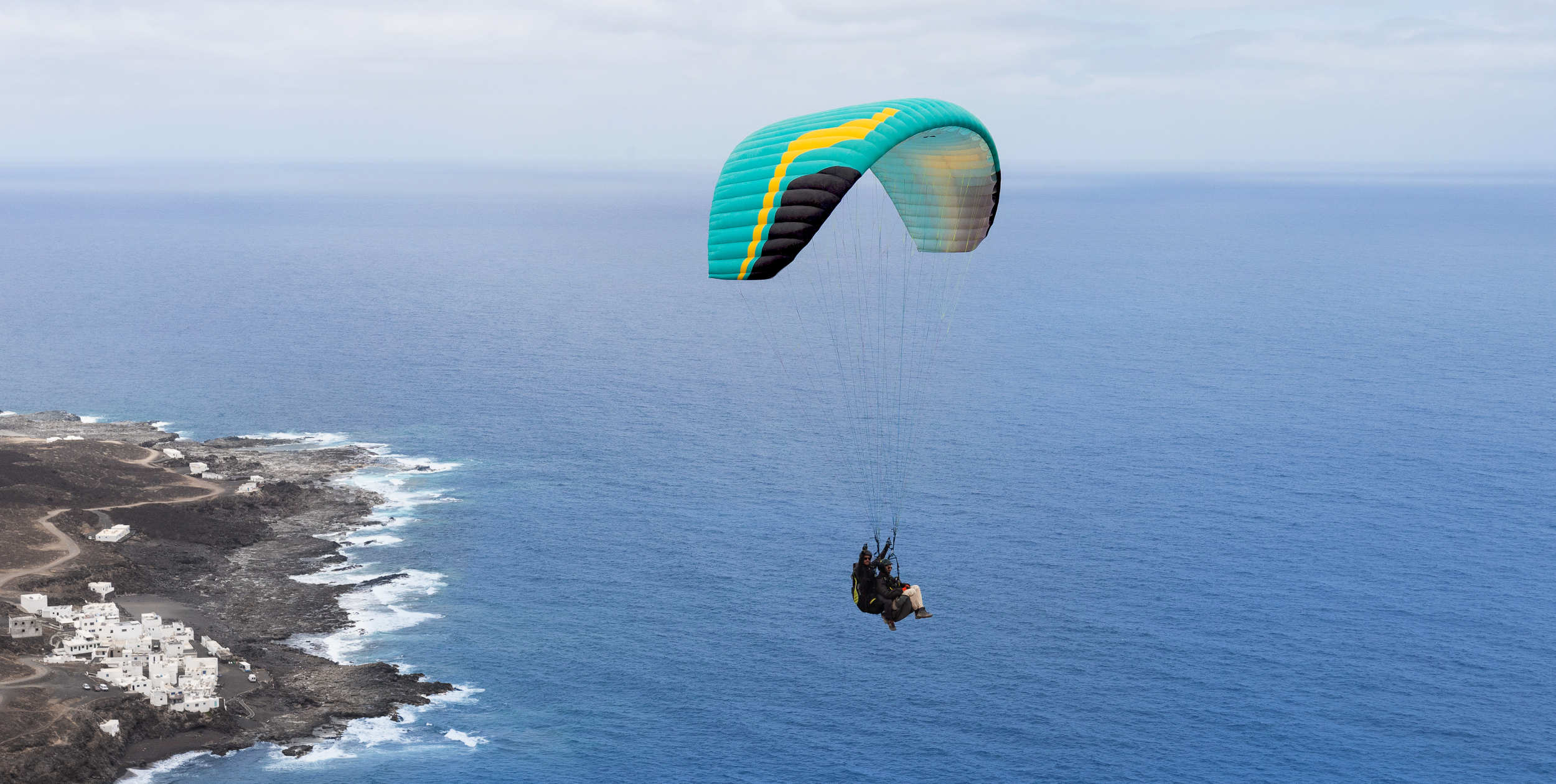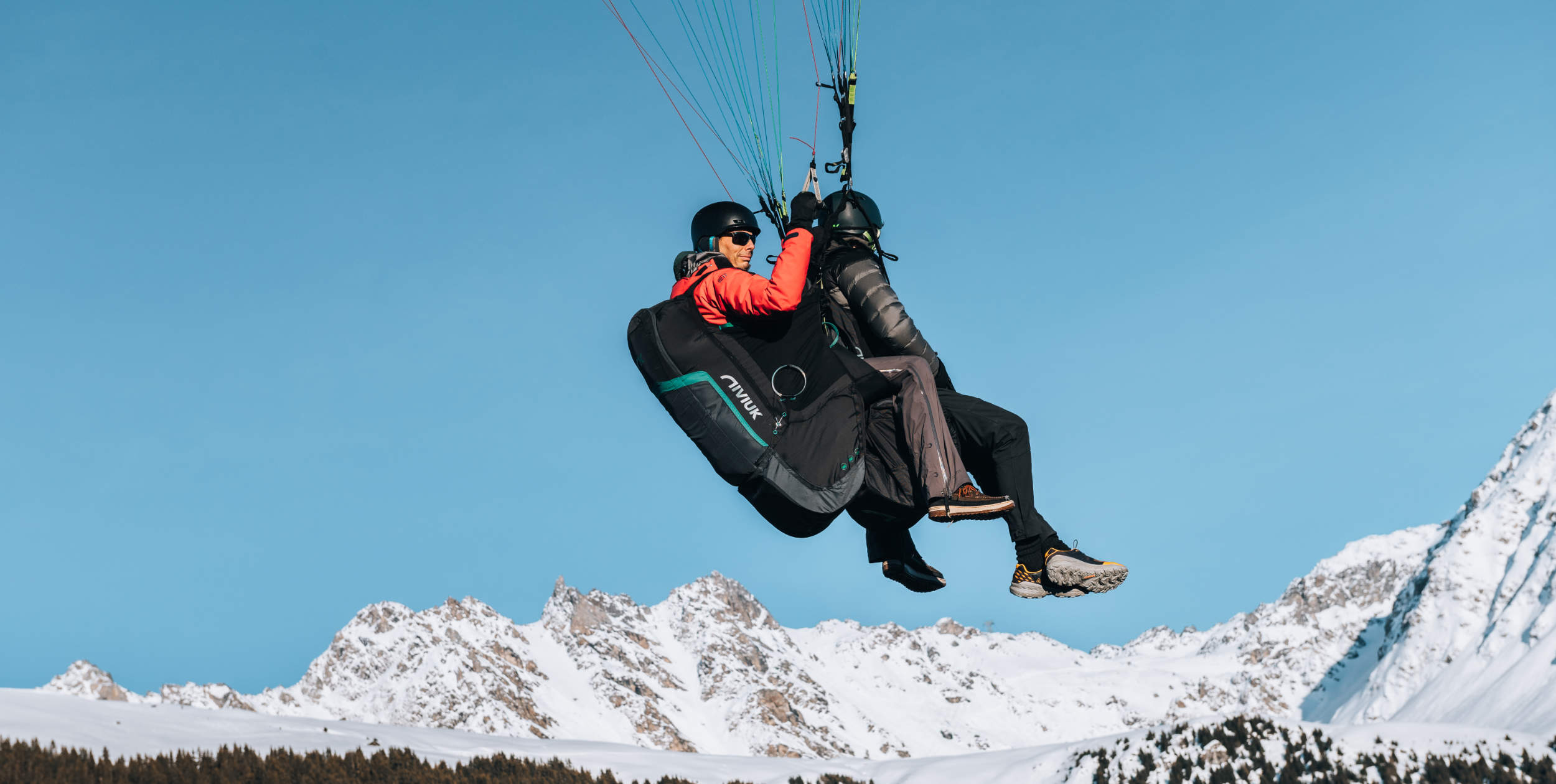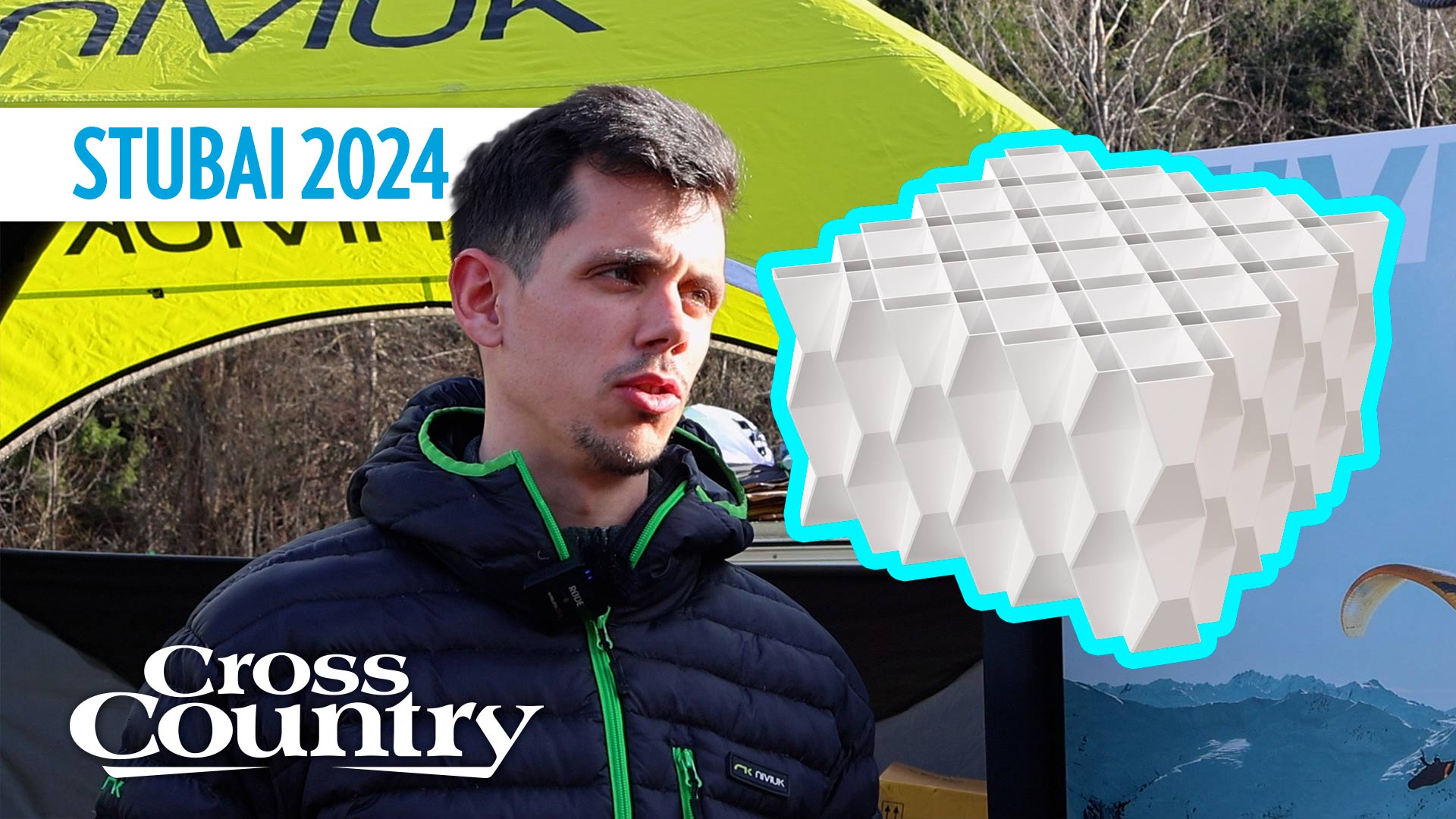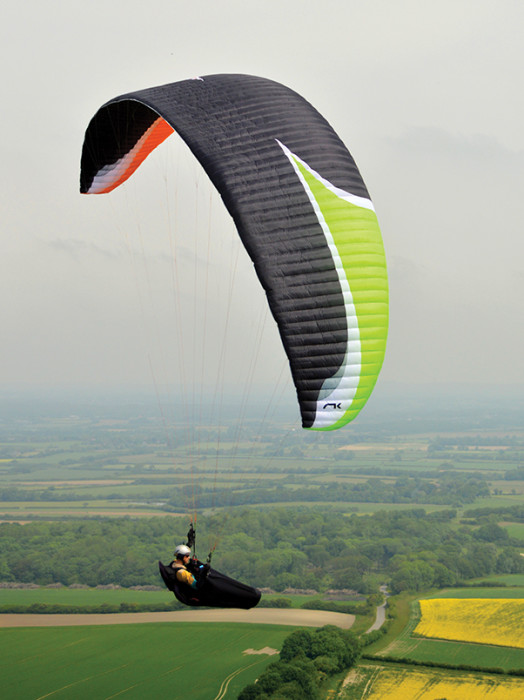
No surprises here: the top surface of the Peak 3 is one of the cleanest we’ve seen. Photo Mike Stiff
Bangin’ Climbs and Surfin’ Lines: Hugh Miller discovers Niviuk’s Peak 3 (EN D) is a weapon built for fast and furious mountain flying
Published in issue 148
Some people are just NEVER happy, are they!” said Guy Anderson. I’d been asking for a go on his Icepeak 23 to compare it to the Peak 3 23 – as I just didn’t feel I was quite getting the hang of it. It was the day after I’d flown my personal best – a 209 km XC on the Peak 3, which was my second ever flight on the wing. So I guess with hindsight I can understand some of his incredulity. Yet I am going to stick to my guns. The Peak 3 may well be the wing of the moment in its class, but I think it takes quite a bit of getting used to. Let me explain.
The design
Cross country addicts the world over have been salivating over the arrival of the Peak 3, the first certified 2.5 liner to be marketed as an ‘accessible’ EN D. It’s a two-liner with just two risers, but the rear lines split near the top to make Bs and Cs. Niviuk’s Icepeak 6 won the hearts of pilots the world over last year and it’s still widely considered the most sorted competition wing, and much of its pedigree has been packed into the Peak 3, though its aspect ratio is lower at 6.5. It features rear-riser handles and looks like it’s built to race. Unravelling the glider, the first thing you notice is the incredibly aggressive leading edge, with thin cell openings and a huge shark nose. It’s like nothing I’ve ever seen before!
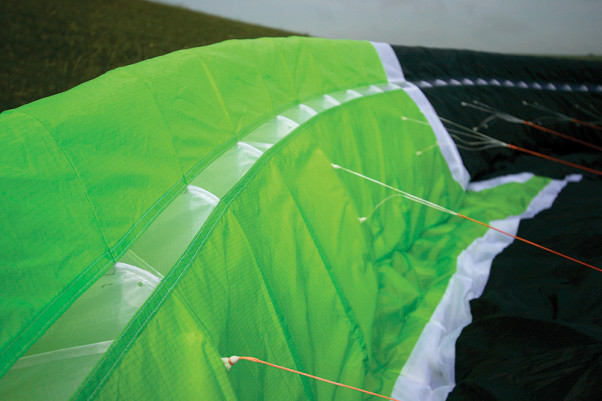
The punchy shark’s nose leading edge, with the A-line tabs set well in from the cell openings.
Photo: Hugh Miller
First day out
You’d be pushed to call this a hill, let alone a site. I’m stood on Liddington, a shallow 60m high sloping field and the wind’s blowing hard from the side. It’s not the ideal first day out I’d hoped for, but acro pilot Ant Green is making it all look easy, sliding and skating about the rabbit-hole strewn ridge like it’s a snowfield. The rest of us are doing into-wind beats and slope-landing half way. Pulling up the Peak 3 requires some effort on the inside A-lines, but there’s none of the shoot-and-dump tendencies of competition wings. I later discover it launches perfectly in nil wind too.
Soon the air starts to liven up, and coming from a spring flying an EN C, I find the Peak 3 needs much more management in the rough, wind-torn thermals low down. Lots of pitch control needed to stop the tips from surging forward – you’ll need a firmer hand than you’d need on three-line Ds like the Omega 8, Mantra 4 or Gin GTO, too.
The brakes felt like taut wires, with light and long brake travel. I found I was unsure how much brake to use, as the feedback was so different from three-line designs, and while my friends pulled themselves skywards I was left dangling down low like a very incompetent climber who doesn’t have enough chalk in his bag or strength in his fingers. I started to use more and more inside brake – far more than I’d needed on the Delta 2 – and then things clicked a little, and it was with huge relief that I finally started climbing out and we were on our way.
I soon noticed that the Peak 3 likes her climbs strong. I found it hard to ‘float’ in weaker climbs, but when I found a solid core she really started performing. She’s like a hungry dog that’s only satisfied with a good lump of meat to sink her teeth into – bony scraps won’t do. After an hour or so, I found myself with Ant Green in proper mincing mode, wafting up in overcast skies. I must have been starting to get the hang of flying it, but it all did seem quite unfamiliar. After 50km or so I was starting to settle in and enjoy the wing – and my final glide was just phenomenal, a mind-blowing cruise to a railway station that I’d never have thought I could reach on a three-liner.
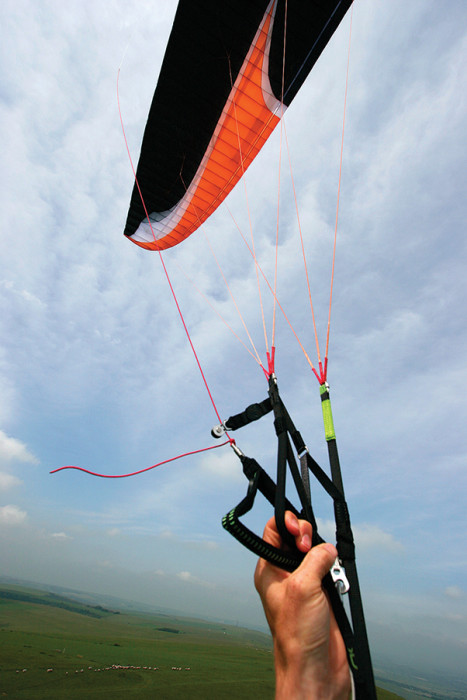
The handles are perfectly positioned so the brakes are at the keepers as you grip them. There is loads of pressure through the rear risers, and you’ll get a good workout gliding actively with these!
Photo: Hugh Miller
Getting epic
Three days later and we were on a mission, making a four-hour drive to a site well inland with a declared record attempt. We arrived at the site with a strong cross-wind but a good street sitting just over take-off. Mark Watts, Kirsty Cameron, Kenny McPhee, Neil Roberts and I were soon up and off in a 1m/s climb and we all reached base at the same time. Again, the Peak 3’s character suited searching for a good core and riding it hard. That might sound obvious, but other wings – the R11 for example, will just sniff around and gobble up whatever she finds. The Peak 3 likes to get locked in to something meaty and get on with it. It turns much flatter than my Icepeak 21 and doesn’t give me the same feedback I’m used to in weak climbs from recent Air Design, Nova, Ozone, Gin and Advance wings I’ve flown.
Later on in the flight, I find myself searching for lift under a lumpy grey cloud. It’s got to work somewhere, but I’m a little clueless. I go right 50m, Mark goes left 50m and starts specking out. I have to remind myself he’s one of the best pilots in the world – but he really did make me feel amateur. In strong, smooth climbs, the wing turned fine, but in turbulent climbs I struggled to get consistent, smooth 360s – the wing would want to straighten up, and need working back into the core. This tendency was most pronounced during bullet-like cores travelling up the into-wind section of the thermal. It feels like it’s trimmed quite nose-down, so it cuts into stuff, essential in rough air, but perhaps a little too deeply to surf up the energy in weaker, broken up climbs.
As the thermals consolidated, the wing’s responsiveness and climb performance went through the roof. I adapted to using more inside brake than I’m used to. I flew an Icepeak 21 and loved its roll authority, though I was well-loaded on that, and mid-range in the Peak 23. Apparently this is the case with the R11 too – you push in the brake and stop, worried you might spin it, but in time you learn to trust it and bury it some more. I’d also recommend flying it with a harness with a seat-board to give you more roll authority through weightshift – sometimes I felt like I was rolling in a hammock in my Impress 3. Perhaps I just got really used to the more compact handling of the C class and was missing that.
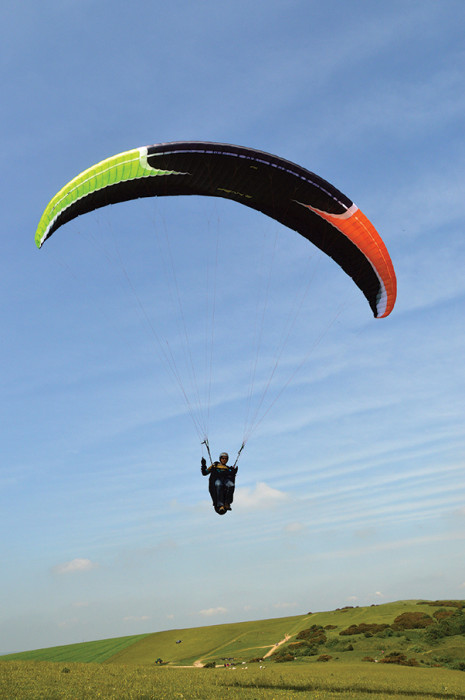
In 2013 there’s a fantastic array of choice in the market. The Peak 3 sits right at the top: a pedigree, advanced design. Having flown an R11, R10 and Icepeak, the Peak 3 does feel like the most accessible two- or 2.5-liner – but be warned, it’s still a jump up from any EN D three-liner. Ultimately it will take an active and confident pilot to get the most out of its performance in real conditions. To really fly it well, it’d be worth investing in some good SIV or pilotage training so you can fly it right at the top of your game.
Photo: Mike Stiff
On glide
The Peak 3 really impressed me on glide. Over the six-hour, 200km flight, Kirsty’s EnZo only seemed fractionally better. The bar is light and comfortable, and I felt very confident on bar. That’s where the wing wanted to be: pushed hard. I also settled into the wing, getting used to keeping some tension on the C-risers, and surfing some of the better lines we were enjoying. We flew out of the Welsh borders, the sun glinting over the Severn bridge to our right, climbed right over the flying sites of the Cotswolds, and glided over Prince Charles’ house at Highgrove. The day was turning more and more on, meaning faster flying, quicker connections with stronger climbs, and more time on the bar. It felt like the Peak 3 was waking up too and coming in to its own.
I wondered if strong thermals and fast glides – “bangin climbs and surfin lines”, as Barney Woodhead puts it – are the natural home for this wing. If you’re flying in the mountains on a strong day where you basically motor to a sunny into-wind face and only turn when you see the trees thrashing and grazing cows being blown sideways, the Peak 3 would open up the sky like a sailplane to you. In the recent French Championships, Simon Issenhuth won a task on a Peak 3 against a field of Icepeak 6s and EnZos – this kind of proves my point, I think.
Safety
I’m out of my depth here – I’m not experienced enough to comment on the safety of two- or 2.5-liners. I searched for spin, and the Peak 3 reacted very predictably – spin point is more subtle than three-line Ds but you’ll feel it when you reach it. I found it impossible to pull big ears. I couldn’t reach high enough to pull enough outer A-line in to get a stable collapse – and with so much pressure, the leading edge just wants to rip the line out of your hand and re-open! I talked to instructor Tony Bolenor at Flyeo, the SIV school in Annecy, and he told me, “For safety it is much better than the pure two-liners”.
He continued, “I have seen Peak 3 pilots over the lake go into stall then release to tail slide, and it is a baby. It’s very predictable and easy. The same goes for induced collapses.”
I told him what I’d found with the handling, and he agreed, but told me that with less than 10 hours on the wing, I just needed to make some adjustments.
“I know what you mean,” he said. “I have flown it for seven hours, and it’s taken me longer than other wings to get used to it. It climbs really well in the thermals, and I find I have to use a lot more brake than I am used to. You can really bury the brake, and it has no spin tendency. If you do this, it turns tighter. And with the performance, you don’t need so many thermals anyway! I flew 80km yesterday with just three thermals!”
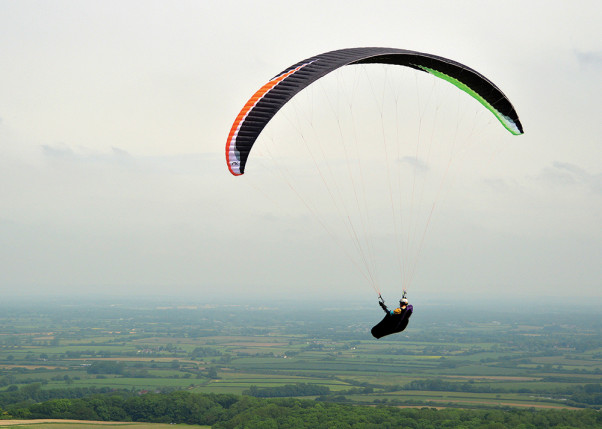
With no middle lines or risers, a much higher proportion of the pilot’s weight is suspended from the A-risers, increasing the loading at the leading edge. Generally, two and 2.5-liners are very different in their handling and feel to three-liners. To use a car analogy, they have harder suspension. Photo: Mike Stiff
Personal taste
On my last day testing, it’s a weak thermal day. I am lighter loaded, and finally getting the hang of it, and though I can’t turn it tightly, I am starting to work out what makes her tick. (By the way – if you think this or other high aspect wings turn well, go fly a Mentor 3 or Aspen 4. It will blow your mind).
Testing wings really is an inexact science. I find I’m most drawn to the wing that most resembles your last wing – or has tauter handling. I loved the Delta 2. I didn’t immediately click with the Peak 3. They are poles apart in terms of their style and appeal. But I grew to really appreciate the Peak 3’s pedigree performance. If you want to keep up with the EnZo and Icepeak 6 friends, then this is a very, very good bet. One test flight will be enough for you to get the sense of the Peak 3’s handling, and you can then decide if you want to invest some time learning to fly it really well. The rewards for doing so will be huge, in terms of sheer reach and performance.
Conclusion
The Peak 3 is a revolutionary XC racing wing, serving up the same glide performance as many of the competition wings of the last two years in a more accessible package. I am grateful for the ride it gave me on the longest flight I’ve ever done, and it really comes alive when the day switches on. But – and you knew there was a but coming, didn’t you? – call me a cautious Carol, I’m not sure I’m yet ready for a wing of this calibre.
Sure, I felt fine on it in the weak flatlands, but I don’t know if it’s floaty enough for consistently weak air. I also feel like I’d need to do more SIV training to feel really on top of my game before I take a wing like this into the mountains, its natural environment. Having said that, given Flyeo’s advice, that says more about me than the wing. Perhaps I’m not the best pilot to be reviewing it.
And my slight quibbles about the handling kind of get steam-rolled in the mountains anyway, where fast pilots spend as little time circling and as much time straight-lining as it is. In Burki Marten’s book Cross Country Flying, circling in thermals is described as “flying backwards” – you want to be cracking on as fast as you can, surfing not circling. In that respect, the Peak 3 is much like a hang glider, serving up an incredible glide, but sometimes needing a firm hand. And with Ozone recently announcing a delay on the release of their new D, the sky is wide open for Niviuk’s Peak 3. You just be careful out there on these new performance wings, OK?
Peak 3 Specs
Sizes: 21, 23, 25, 27
Weight ranges (kg):
70-85, 80-97, 90-110, 105-125
Number of cells: 69
Aspect Ratio: 6.5
Weight (kg): 5.3, 5.5, 5.7, 5.85
Line consumption (m):
188, 193, 201, 209
Risers: A/B
Trimmers: No
EN: D
Technology acronyms
SLE: Structured leading edge. Provides more rigidity and stability along the span of the leading edge. “Ensures ease of movement on the ground and high security in the air.”
STE: Structured trailing edge. Based on technology used in the Icepeak 4. “Optimises the profile without deforming it.” That means, when you control pitch (brakes) “it is the entire surface that starts to bend, not only its trailing edge.”
• Got news?
Send it to us at news@xccontent.local.
Subscribe to the world’s favourite hang gliding and paragliding magazine


